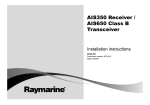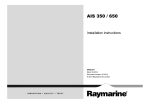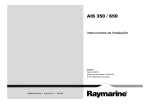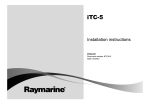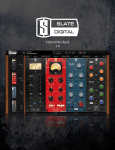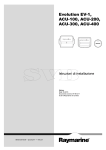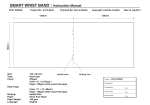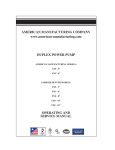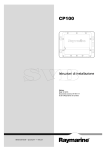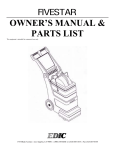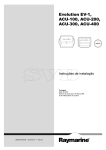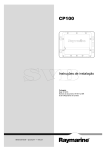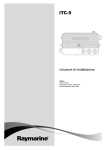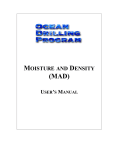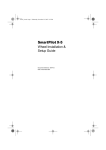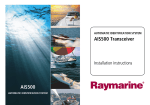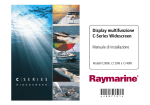Download View - Fondriest Environmental, Inc.
Transcript
AIS 3 5 0 Re c e ive r / AIS 6 5 0 C la s s B Tr a n s c e ive r Ins ta lla tion ins tructions ENGLIS H Docume nt numbe r: 87140-2 Da te : 05-2011 Trademark and patents notice Autohelm, hsb2, RayTech Navigator, Sail Pilot, SeaTalk, SeaTalkNG, SeaTalkHS and Sportpilot are registered trademarks of Raymarine UK Limited. RayTalk, Seahawk, Smartpilot, Pathfinder and Raymarine are registered trademarks of Raymarine Holdings Limited. FLIR is a registered trademark of FLIR Systems, Inc. and/or its subsidiaries. All other trademarks, trade names, or company names referenced herein are used for identification only and are the property of their respective owners. This product is protected by patents, design patents, patents pending, or design patents pending. Copyright ©2011 Raymarine UK Ltd. All rights reserved. ENGLISH Document number: 87140-2 Date: 05-2011 Contents Chapter 1 Important information............................. 7 3.2 Static data requirement ............................................. 32 Applicability .................................................................... 7 3.3 Requirements for USA & Canada ............................... 33 Safety information........................................................... 7 General information ........................................................ 8 3.4 Requirements for areas outside of USA & Canada.......................................................................... 36 AIS overview .................................................................. 9 3.5 Planning the installation............................................. 37 3.6 Cables and connections ............................................ 40 Classes of AIS................................................................ 10 System protocols ............................................................ 12 3.7 Connections overview ............................................... 41 Chapter 2 AIS350 Receiver ...................................... 15 3.8 GPS antenna connection ........................................... 42 3.9 VHF connection ........................................................ 43 2.1 AIS350 Receiver unit................................................. 16 2.2 Planning the installation............................................. 16 3.10 Multifunction display connections ............................. 44 3.11 AIS Silent mode connection ..................................... 45 2.3 Cables and connections ............................................ 19 3.12 Power connection.................................................... 46 2.4 Connections overview ............................................... 20 2.5 VHF connection ........................................................ 21 3.13 USB connection ...................................................... 48 2.6 Multifunction display connections ............................... 22 3.15 SD Card connection ................................................ 49 2.7 Power connection ..................................................... 23 3.16 Location and mounting ............................................ 50 2.8 USB connection ........................................................ 25 3.17 System checks........................................................ 54 2.9 Location and mounting .............................................. 26 3.18 Diagnostics ............................................................. 56 3.19 Troubleshooting ...................................................... 56 2.10 System checks........................................................ 27 3.14 Installing proAIS2 and USB drivers........................... 49 2.11 Troubleshooting....................................................... 28 2.12 Technical specification ............................................. 29 3.20 Technical specification ............................................. 58 Chapter 3 AIS650 Class B transceiver.................... 31 4.1 Raymarine customer support ..................................... 62 3.1 AIS650 Class B transceiver unit ................................. 32 Chapter 4 Technical support ................................... 61 Chapter 5 Options and accessories ....................... 63 5 5.1 SeaTalkng cables and accessories .............................. 64 5.2 Spares and accessories ............................................ 65 6 AIS350 / AIS650 Installation instructions Chapter 1: Important information Applicability The information in this book applies to all geographical areas unless otherwise stated. Safety information Warning: Product installation and operation This product must be installed and operated in accordance with the instructions provided. Failure to do so could result in personal injury, damage to your vessel and/or poor product performance. Warning: Switch off power supply Ensure the vessel’s power supply is switched OFF before starting to install this product. Do NOT connect or disconnect equipment with the power switched on, unless instructed in this document. Warning: Potential ignition source This product is NOT approved for use in hazardous/flammable atmospheres. Do NOT install in a hazardous/flammable atmosphere (such as in an engine room or near fuel tanks). Important information Warning: Ensure safe navigation This product is intended only as an aid to navigation and must never be used in preference to sound navigational judgment. Only official government charts and notices to mariners contain all the current information needed for safe navigation, and the captain is responsible for their prudent use. It is the user’s responsibility to use official government charts, notices to mariners, caution and proper navigational skill when operating this or any other Raymarine product. Caution: Power supply protection When installing this product ensure the power source is adequately protected by means of a suitably-rated fuse or automatic circuit breaker. RF safety notice RF radiation statement AIS transceivers generate and radiate radio frequency (RF) electromagnetic energy (EME). Safe compass distance Safe compass distance is 1 meter minimum for any compass. Some compass types may require greater distances. To be sure, you should locate your AIS unit as far as possible from the compass. Test your compass to verify proper operation while the AIS unit is also operating. 7 General information Caution: Cleaning When cleaning this product: • Do NOT wipe the display screen with a dry cloth, as this could scratch the screen coating. • Do NOT use abrasive, or acid or ammonia based products. • Do NOT use a jet wash. EMC installation guidelines Raymarine equipment and accessories conform to the appropriate Electromagnetic Compatibility (EMC) regulations, to minimize electromagnetic interference between equipment and minimize the effect such interference could have on the performance of your system Correct installation is required to ensure that EMC performance is not compromised. For optimum EMC performance we recommend that wherever possible: • Raymarine equipment and cables connected to it are: – At least 1 m (3 ft) from any equipment transmitting or cables carrying radio signals e.g. VHF radios, cables and antennas. In the case of SSB radios, the distance should be increased to 7 ft (2 m). – More than 2 m (7 ft) from the path of a radar beam. A radar beam can normally be assumed to spread 20 degrees above and below the radiating element. • The product is supplied from a separate battery from that used for engine start. This is important to prevent erratic behavior 8 and data loss which can occur if the engine start does not have a separate battery. • Raymarine specified cables are used. • Cables are not cut or extended, unless doing so is detailed in the installation manual. Note: Where constraints on the installation prevent any of the above recommendations, always ensure the maximum possible separation between different items of electrical equipment, to provide the best conditions for EMC performance throughout the installation Suppression ferrites Raymarine cables may be fitted with suppression ferrites. These are important for correct EMC performance. If a ferrite has to be removed for any purpose (e.g. installation or maintenance), it must be replaced in the original position before the product is used. Use only ferrites of the correct type, supplied by Raymarine authorized dealers. Connections to other equipment Requirement for ferrites on non-Raymarine cables If your Raymarine equipment is to be connected to other equipment using a cable not supplied by Raymarine, a suppression ferrite MUST always be attached to the cable near the Raymarine unit. Declaration of conformity Raymarine Ltd. declares that this product is compliant with the essential requirements of EMC directive 2004/108/EC. The original Declaration of Conformity certificate may be viewed on the relevant product page at www.raymarine.com. AIS350 / AIS650 Installation instructions Product disposal AIS disclaimer Dispose of this product in accordance with the WEEE Directive. All information presented by the Raymarine AIS device is advisory only, as there is a risk of incomplete and erroneous information. By placing this product into service you acknowledge this and assume complete responsibility for any associated risks, and accordingly release Raymarine and SRT Marine Technology Ltd from any and all claims arising from the use of the AIS service. The Waste Electrical and Electronic Equipment (WEEE) Directive requires the recycling of waste electrical and electronic equipment. Whilst the WEEE Directive does not apply to some Raymarine products, we support its policy and ask you to be aware of how to dispose of this product. Warranty registration To register your Raymarine product ownership, please visit www.raymarine.com and register online. It is important that you register your product to receive full warranty benefits. Your unit package includes a bar code label indicating the serial number of the unit. You will need this serial number when registering your product online. You should retain the label for future reference. IMO and SOLAS The equipment described within this document is intended for use on leisure marine boats and workboats not covered by International Maritime Organization (IMO) and Safety of Life at Sea (SOLAS) Carriage Regulations. Technical accuracy To the best of our knowledge, the information in this document was correct at the time it was produced. However, Raymarine cannot accept liability for any inaccuracies or omissions it may contain. In addition, our policy of continuous product improvement may change specifications without notice. As a result, Raymarine cannot accept liability for any differences between the product and this document. Important information Installation guide Information scope This document gives introductory, installation and troubleshooting information for your Raymarine Automatic Identification System (AIS) device. Refer to the proAIS2 User Manual and the operating manual for your Raymarine Multifunction Display, for instructions on how to configure and operate your AIS system. All documents are available to download as PDFs from www.raymarine.com AIS overview Your AIS device uses digital radio signals to exchange ’real-time’ information between vessels, shore based stations, or aids to navigation (AToNs) on dedicated VHF frequencies. This information is used to identify and track vessels in the surrounding area and to provide fast, automatic and accurate collision avoidance data. Although AIS augments your radar application by operating in radar blind spots and detecting smaller AIS-fitted vessels, it does not replace radar, as it relies on receiving transmitted AIS information and therefore cannot detect objects such as landmasses and navigational beacons. NEVER assume that AIS is displaying information from all vessels in the area, because: 9 • Not all vessels are fitted with AIS • Although it is mandatory for larger commercial vessels to carry AIS, it is not mandatory to use it. AIS should be used only to augment radar information, not substitute it. • Dynamic data. Includes information such as time (UTC), ship’s position, COG, SOG, heading, rate of turn and navigational status. • Dynamic reports. Ship’s speed and status. • Messages. Alarms and safety messages. Remember that not all vessels will transmit all of the information. Warning: AIS limitation Never assume that your AIS is detecting all vessels in the area. Always exercise due prudence and do not use AIS as a substitute for sound navigational judgement. Classes of AIS Class B transceivers Class B AIS transceivers transmit and receive AIS signals, but use a reduced set of data compared to Class A (see Data Summary). A Class B AIS transceiver can be fitted on any vessel not fitted with a Class A transceiver, but is not mandatory aboard any vessel. Data Summary Receiver (receive) Transceiver (transmit) Transceiver (receive) Ship’s name Yes Yes Yes Type Yes Yes Yes Call sign Yes Yes Yes Class A transceivers IMO number Yes No Yes Class A AIS transceivers transmit and receive AIS signals. AIS transceivers are currently mandatory on all commercial vessels exceeding 300 tons that travel internationally (SOLAS vessels). The following information can be transmitted by a Class A AIS system: Length and beam Yes Yes Yes Antenna location Yes Yes Yes Draft Yes No Yes • Static data. Includes information such as vessel name, vessel type, MMSI number, call sign, IMO number, length, beam and GPS antenna location. Cargo Information Yes Yes Yes Destination Yes No Yes ETA Yes No Yes The AIS350 is a receiver that receives messages from vessels, land base stations, or aids to navigation (AToNs) carrying Class A or Class B transceivers. The AIS650 is a Class B transceiver that receives messages from and transmits messages to vessels, land base stations, or aids to navigation (AToNs) carrying Class A or Class B transceivers. Data • Voyage related data. Includes information such as draft, cargo, destination, ETA and other relevant information. 10 AIS350 / AIS650 Installation instructions Data Receiver (receive) Transceiver (transmit) Transceiver (receive) Time Yes Yes Yes Ship’s position Yes Yes Yes COG Yes Yes Yes SOG Yes Yes Yes Gyro heading Yes Yes* Yes Rate of turn Yes No Yes Navigational status Yes No Yes Safety message Yes No Yes Class A systems Ships Dynamic Conditions Reporting rate At anchor or moored 3 Minutes 0-14 knots 10 Seconds 0-14 knots and changing course 31/3 Seconds 14-23 knots 6 Seconds 14-23 knots and changing course 2 seconds Faster than 23 knots 2 seconds Faster than 23 knots and changing course 2 seconds Class B systems *Class B transceivers do not transmit a Gyro heading unless the transceiver is receiving an NMEA HDT sentence from an external source. Data reporting intervals AIS information is classed as either static or dynamic. Static information is broadcast, when data has been amended, or upon request, or by default, every 6 minutes. The reporting rates for dynamic information depend on speed and course change, and are given in the following tables. Note: The reporting rates shown here are for reference and may not be the rate at which information is actually received by your AIS transceiver. This is dependent on a number of factors, including but not limited to antenna height, gain and signal interference. Important information Ships Dynamic Conditions Reporting rate 0 to 2 knots 3 Minutes Above 2 knots 30 Seconds Other AIS sources Source Reporting rate Search and Rescue (SAR) aircraft 10 seconds Aids to navigation 3 minutes AIS base station 10 seconds or 3.33 seconds, depending on operating parameters 11 System protocols Your product can be connected to various products and systems to share information and so improve the functionality of the overall system. These connections may be made using a number of different protocols. Fast and accurate data collection and transfer is achieved by using a combination of the following data protocols: SeaTalkng • • NMEA2000 • NMEA0183 Note: You may find that your system does not use all of the connection types or instrumentation described in this section. Seatalkng SeaTalkng (Next Generation) is an enhanced protocol for connection of compatible marine instruments and equipment. It replaces the older SeaTalk and SeaTalk2 protocols. SeaTalkng utilizes a single backbone to which compatible instruments connect using a spur. Data and power are carried within the backbone. Devices that have a low draw can be powered from the network, although high current equipment will need to have a separate power connection. SeaTalkng is a proprietary extension to NMEA 2000 and the proven CAN bus technology. Compatible NMEA 2000 and SeaTalk / SeaTalk2 devices can also be connected using the appropriate interfaces or adaptor cables as required. NMEA 2000 NMEA 2000 offers significant improvements over NMEA 0183, most notably in speed and connectivity. Up to 50 units can simultaneously transmit and receive on a single physical bus at any one time, with each node being physically addressable. The standard 12 was specifically intended to allow for a whole network of marine electronics from any manufacturer to communicate on a common bus via standardized message types and formats. NMEA 0183 The NMEA 0183 Data Interface Standard was developed by the National Marine Electronics Association of America. It is an international standard to enable equipment from many different manufacturers to be connected together and share information. The NMEA 0183 standard carries similar information to SeaTalk. However it has the important difference that one cable will only carry information in one direction. For this reason NMEA 0183 is generally used to connect a data receiver and a transmitter together, e.g. a compass sensor transmitting heading to a radar display. This information is passed in ‘sentences’, each of which has a three letter sentence identifier. It is therefore important when checking compatibility between items that the same sentence identifiers are used some examples of which are: • VTG - carries Course and Speed Over Ground data. • GLL - carries latitude and longitude. • DBT - carries water depth. • MWV - carries relative wind angle and wind speed data. NMEA baud rates The NMEA 0183 standard operates at a number of different speeds, depending upon the particular requirement or equipment capabilities. Typical examples are: • 4800 baud rate. Used for general purpose communications, including FastHeading data. • 9600 baud rate. Used for Navtex. • 38400 baud rate. Used for AIS and other high speed applications. AIS350 / AIS650 Installation instructions NMEA Connections You can connect your transceiver to your VHF radio set and a multifunction display using the NMEA connections on the power/data cable. The transceiver’s power and data connector provides NMEA0183 connections at both 4800 baud and 38400 baud rates, as follows: Wire color NMEA0183 Function Yellow 4800 baud IN - Gray 4800 baud IN + Pink 4800 baud OUT – Purple 4800 baud OUT + Green 38400 baud IN - White 38400 baud IN + Blue 38400 baud OUT - Brown 38400 baud OUT + A multiplexer built into the transceiver manages both 4800 and 38400 baud rates. This feature effectively frees up an NMEA port on your multifunction display. If only one NMEA0183 port exists on your equipment, the multiplexer eliminates the need for a separate multiplexer. Typically the NMEA0183 connections are used as follows: • The 4800 baud wires connect to the appropriate points on the VHF radio or other NMEA0183 4800 baud input/output device. • The 38400 baud wires connect to appropriate Raymarine multifunction display. The NMEA0183 port on each display connected in this manner must be set to 38400 baud. Important information 13 14 AIS350 / AIS650 Installation instructions Chapter 2: AIS350 Receiver Chapter contents • 2.1 AIS350 Receiver unit on page 16 • 2.2 Planning the installation on page 16 • 2.3 Cables and connections on page 19 • 2.4 Connections overview on page 20 • 2.5 VHF connection on page 21 • 2.6 Multifunction display connections on page 22 • 2.7 Power connection on page 23 • 2.8 USB connection on page 25 • 2.9 Location and mounting on page 26 • 2.10 System checks on page 27 • 2.11 Troubleshooting on page 28 • 2.12 Technical specification on page 29 AIS350 Receiver 15 2.2 Planning the installation 2.1 AIS350 Receiver unit Installation checklist Installation includes the following activities: Installation Task AIS 350 Re ce ive r S ta tus US B P WR/Da ta S Tng 1 Plan your installation. 2 Obtain all required equipment and tools. 3 Mount the system components. 4 Route all cables. 5 Drill cable and mounting holes. 6 Make all connections to equipment. 7 Secure all equipment in place. 8 Complete the post-installation check. VHF ANT D12126-1 AIS350 system The following illustrations show examples of AIS350 systems. 16 AIS350 / AIS650 Installation instructions Simple system example Extended system example 1 3 1 6 4 5 3 4 2 2 AIS 350 Re ce ive r S ta tus AIS 350 Re ce ive r S ta tus RF US B P WR/Da ta S Tng US B P WR/Da ta S Tng VHF ANT VHF ANT 0 0 0 12 V / 24 V SeaTalkng SeaTalkng 12 V / 24 V NMEA0183 - 4800 D12084-1 D12085-1 Item Description Item Description 1. VHF antenna 1. VHF Antenna 2. AIS350 receiver unit 2. VHF Radio 3. Multifunction display 3. VHF Splitter (Not supplied) 4. Vessel’s existing GPS antenna 4. AIS350 receiver unit 5. Multifunction display 6. Vessel’s existing GPS antenna AIS350 Receiver 17 Note: It is not recommended that a multifunction display is connected using both SeaTalkng and NMEA0183 at the same time, as data conflicts could occur. Item Description 3. 2 m power/data cable 4. Document pack contains: Pack contents • Installation instruction The AIS350 model contains the following items: • Support software CD-ROM • Warranty registration card 1 2 5. SeaTalkng Dust cap 6. 1 m SeaTalkng spur cable AIS 350 Re ce ive r S ta tus Unpack the AIS unit carefully to prevent damage. Save the carton and packing in case the unit has to be returned for service. US B P WR/Da ta S Tng VHF ANT Tools required Tools required for installation 3 1 2 4 5 6 3 D12086-1 Item Description 1. AIS350 receiver unit 2. 4 x Fixing screws 18 D12087-1 AIS350 / AIS650 Installation instructions Item Description 1. Power Drill 2. Screwdriver 3. 3.2 mm (1/8”) drill bit 2.3 Cables and connections General cabling guidance Cable types and length It is important to use cables of the appropriate type and length • Unless otherwise stated use only standard cables of the correct type, supplied by Raymarine. • Ensure that any non-Raymarine cables are of the correct quality and gauge. For example, longer power cable runs may require larger wire gauges to minimize voltage drop along the run. Routing cables Cables must be routed correctly, to maximize performance and prolong cable life. • Do NOT bend cables excessively. Wherever possible, ensure a minimum bend radius of 100 mm. Minimum bend 200 mm (8 in) diameter Minimum bend of cable 100 mm (4 in) radius • Protect all cables from physical damage and exposure to heat. Use trunking or conduit where possible. Do NOT run cables through bilges or doorways, or close to moving or hot objects. • Secure cables in place using tie-wraps or lacing twine. Coil any extra cable and tie it out of the way. • Where a cable passes through an exposed bulkhead or deckhead, use a suitable watertight feed-through. • Do NOT run cables near to engines or fluorescent lights. AIS350 Receiver 19 Always route data cables as far away as possible from: • other equipment and cables, 2.4 Connections overview The receiver has the following connection types: • high current carrying ac and dc power lines, • antennae. Strain relief Ensure adequate strain relief is provided. Protect connectors from strain and ensure they will not pull out under extreme sea conditions. AIS 350 Re ce ive r S ta tus US B Circuit isolation Appropriate circuit isolation is required for installations using both AC and DC current: 4 • Always use isolating transformers or a separate power-inverter to run PC’s, processors, displays and other sensitive electronic instruments or devices. • Always use an isolating transformer with Weather FAX audio cables. • Always use an isolated power supply when using a 3rd party audio amplifier. • Always use an RS232/NMEA converter with optical isolation on the signal lines. P WR/Da ta S Tng VHF ANT 1 2 3 D12088-1 Item Description 1. Power / NMEA0183 (4800 & 38400 baud) / AIS Silent 2. SeaTalkng 3. VHF antenna 4. Mini—B USB (for PC connectivity) • Always make sure that PC’s or other sensitive electronic devices have a dedicated power circuit. Carry out the following procedures to connect up you receiver: Cable shielding • Connecting VHF Ensure that all data cables are properly shielded that the cable shielding is intact (e.g. hasn’t been scraped off by being squeezed through a tight area). • Connecting to Multifunction display. • Connecting power Note: With the USB cover open the unit will not be water resistant. 20 AIS350 / AIS650 Installation instructions 2.5 VHF connection US B P WR/Da ta S Tng VHF ANT Connect up your AIS unit to your vessel’s VHF connections by following the steps found under Connecting RF and Connecting NMEA0183 (low baud rate) below: 1 2 Connecting RF 3 1. Connect a dedicated VHF antenna directly to the VHF antenna connector on your AIS unit, or 2. Using a VHF splitter (not included) link your AIS unit into the ships existing VHF radio set and antenna following the instructions provided with the VHF splitter. 4 Connecting NMEA0183 (low baud rate) Connect the AIS unit’s 4800 baud NMEA0183 bus to the vessel’s VHF radio as follows: 1. Identify the 4800 baud NMEA0183 wires on the AIS units power/data cable. 2. Identify the 4800 baud NMEA0183 wires on your VHF set 3. Connect the wires as shown below. D12121-1 NMEA0183 (low baud rate) connection to VHF Item AIS wire color AIS signal VHF wire color VHF signal 1. Yellow IN – Brown OUT – 2. Gray IN + Blue OUT + 3. Pink OUT – Purple IN – 4. Purple OUT + Gray IN + Note: The wire colors on your VHF may differ to that shown above, if this is the case then ensure you have connected the correct signals (e.g. IN - on the AIS connects to OUT - on your VHF and so on). AIS350 Receiver 21 2.6 Multifunction display connections US B P WR/Da ta S Tng VHF ANT You can connect your AIS unit to a multifunction display using either the dedicated SeaTalkng connector or NMEA0183 (high baud rate) via the power/data cable. Follow the steps shown in either: • Connecting NMEA0183 (high baud rate, or • Connecting using SeaTalkng 1 Note: Do not connect your multifunction display using both NMEA0183 and SeaTalkng at the same time as this will cause data conflicts. 2 3 4 Connecting NMEA0183 (high baud rate) If your multifunction displays are NOT connected to a SeaTalkng system, connect the AIS unit’s 38400 baud, NMEA0183 bus to your multifunction display’s 38400 baud, NMEA0183 wires. 1. Identify the 38400 baud, NMEA0183 wires on the AIS units power/data cable. 2. Identify the 38400 baud, NMEA0183 wires on your multifunction display. 3. Connect the wires as shown below. 22 D12122-1 NMEA0183 (high baud rate) Multifunction display wire color Multifunction display signal IN – Orange and brown OUT – White IN + Orange and yellow OUT + 3. Blue OUT – Orange and green IN – 4. Brown OUT + Orange and white IN + Item AIS wire color AIS signal 1. Green 2. AIS350 / AIS650 Installation instructions Note: The wire colors on your Multifunction display may differ to that shown above if this is the case then ensure you have connected the correct signals (e.g. IN - on the AIS connects to OUT - on your Multifunction display and so on). The SeaTalkng connector enables you to connect the AIS unit, aboard vessels on which the multifunction displays are connected via SeaTalkng. Before connecting to SeaTalkng, refer to the SeaTalkng Reference Manual, and ensure that with this product connected, the maximum permitted Load Equivalence Number (LEN) value for the system will not be exceeded. Note: Your AIS unit has a SeaTalkng LEN value of 1. Sharing a breaker Where more than 1 piece of equipment shares a breaker you must provide protection for the individual circuits. E.g. by connecting an in-line fuse for each power circuit. +VE bar -VE bar Where possible, connect individual items of equipment to individual circuit breakers. US B S Tng Power supply protection Always protect the power supply by connecting the red (positive) wire to the supply via a 2 A fuse or equivalent automatic circuit breaker. Connecting SeaTalkng P WR/Da ta 2.7 Power connection Where this not possible, use individual in-line fuses to provide the necessary protection. VHF ANT Circuit breaker 1. Connect the supplied SeaTalkng spur cable to the AIS unit’s SeaTalkng connector. 2. Connect the other end of the SeaTalkng spur cable to a suitable place on your vessel’s SeaTalkng network as follows: i. Connect using SeaTalkng 5–way connector. ii. Connect using a SeaTalkng T-Piece connector. iii. Connect using a spare SeaTalkng spur on a SeaTalkng converter. AIS350 Receiver Fuse Fuse D11637-1 D12124-1 23 The preferred minimum requirement for the path to ground (bonded or non-bonded) is via a flat tinned copper braid, with a 30 A rating (1/4 inch) or greater. If this is not possible, an equivalent stranded wire conductor may be used, rated as follows: Warning: Product grounding Before applying power to this product, ensure it has been correctly grounded, in accordance with the instructions in this guide. • for runs of <1 m (3 ft), use 6 mm2 (#10 AWG) (6 mm) or greater. • for runs of >1 m (3 ft), use 8 mm2 (#8 AWG) or greater. Grounding The following requirements apply when grounding Raymarine equipment which does not have a dedicated drain wire or shield: In any grounding system, always keep the length of connecting braid or wires as short as possible. Common ground point The negative wire must be connected to a bonded common ground point, i. e. with the ground point connected to battery negative, and situated as close as possible to the battery negative terminal. Important: Do NOT connect this product to a positively-grounded power system. References • ISO 10133/13297 • BMEA code of practice • NMEA 0400 Connecting power 1 2 3 D11705-1 The use of crimped and soldered lugs is recommended, to provide optimum connection to the power source. 1. Power cable to display 2. Bonded common ground connection Connect your AIS unit’s power cable to either a 12 V dc or 24 V dc power source as follows: 1. Connect the red wire to the 5 A fuse or equivalent automatic circuit breaker to the supply positive terminal. 2. Connect the black wire to the supply negative terminal. 3. Battery Implementation If several items require grounding, they may be first be connected to a single local point (e.g. within a switch panel), with this point connected via a single, appropriately-rated conductor, to the boat’s common ground. 24 AIS350 / AIS650 Installation instructions 2.8 USB connection US B P WR/Da ta S Tng VHF ANT The AIS unit includes a Mini-B USB port which provides PC connectivity. To enable connection of the AIS unit to a PC the USB drivers, supplied on the software CDROM must be installed on the PC The USB port can be used to: • Use of PC based charting software when connected to AIS. • Perform software update 1 Installing USB drivers 2 D12123-1 Item Wire color Description 1. Red Power Supply + 2. Black Power supply – Prior to connecting the AIS to A PC the USB drivers must first be installed. To install follow the steps below: 1. Insert the supplied CDROM and navigate to the USB drivers folder. 2. Double click on the setup.exe file to launch the installer. 3. Follow the on screen installation instructions to complete installation. 4. Once installed the AIS unit can be connected to the PC. The USB drivers will be installed automatically and the AIS will appear as a new COM port device. 5. Select the AIS COM port and a baud rate of 38400 in PC based navigation software to make use of the AIS data. Note: If the USB connection is removed from the PC during use you must reset the connection before further use. To reset the connection disconnect then reapply power to the AIS before closing and re-launching any PC applications using the USB connection. Finally, reconnect the USB cable between the PC and AIS unit. AIS350 Receiver 25 2.9 Location and mounting Unit dimensions D Site requirements AIS requirement AIS 350 Re ce ive r S ta tus This product is NOT approved for use in hazardous/flammable atmospheres. Do NOT install in a hazardous/flammable atmosphere (such as in an engine room or near fuel tanks). US B P WR/Da ta S Tng The AIS unit must be fitted in a location where it is not likely to be stepped on or tripped over, and which: • Has at least 6 in (100 mm) of clear space below, to allow access for cabling and adequate cable bends. • Is maintained at a temperature between -15°C (5°F) and +55°C (130°F). VHF ANT A • Is close enough to allow connection to the vessel’s VHF with the 3 ft (1 m) RF cable supplied. • Is at least 3 ft (1 m) from an engine, compass or any magnetic device. E C When planning the installation, take the following site requirements into account. B F D12042-1 Item Description A. 150 mm (5.90 in) B. 167 mm (6.57 in) C. 50 mm (1.95 in) D. 20.3 mm (0.8 in) E. 99.5 mm (3.92 in) F. 54 mm (2.12 in) Mounting Fitting the AIS unit Note: To ensure water resistance the unit must be mounted vertically with the connectors facing down. 26 AIS350 / AIS650 Installation instructions Note: If you are fitting the AIS unit to fiberglass that has a gelcoat surface, overdrill the surface to prevent the gelcoat from damage when securing the screws. Before drilling the pilot holes, hand drill the marked locations with an oversized bit and countersink to approximately 9.5mm (3/8in) diameter. 1 2 2.10 System checks Switching on When powered on the LED Status indicator shall be bright green and will toggle to dim when messages are received. When the installation is complete, observe the STATUS indicator and: 1. Switch on power to the AIS receiver. 2. Check that: i. When powered on the LED Status indicator shall be bright GREEN and will toggle to dim GREEN when messages are received. 3 Checking for interference Post installation check D12043-1 1. Ensure that the intended installation site meets the conditions described under Site requirements. 2. Using a pencil, offer up the unit and mark the location of the screw holes on the mounting surface. 3. Drill the mounting holes using a 3.2 mm (1/8”) drill bit. 4. Part fit the screws. 5. Place the unit over the screws and move unit down to lock in position 6. Fully tighten the screws. AIS350 Receiver If you have installed any system aboard a boat or made other changes to the boat’s electronic systems (radar, VHF radio etc.), you need to check before casting off, that all electrical systems operate satisfactorily without any undue electrical interference, in order to conform with Electro Magnetic Compatibility (EMC) regulations. To do this: 1. Ensuring it is safe to do so, turn on all electronic systems aboard your vessel. 2. Check that the electronic systems all operate satisfactorily. Using AIS The exact method of using AIS depends on which type of Raymarine multifunction display you are using. Refer to the handbook for your multifunction display for information on using your AIS. 27 2.11 Troubleshooting NMEA2000 Sentences The receiver supports the following Parameter Group numbers (PGNs). Issue Action No power Check: PGN Title • All power connections 129038 Class A position report ● • Check relevant fuses 129039 Class B position report ● • That power supply is at the correct voltage (12 V or 24 V) 129793 AIS UTC and date report ● Check that: 129794 AIS class A static and voyage related data ● 129802 AIS broadcast safety message ● 129041 AtoN position report ● 129809 AIS class B static data part A ● 129810 AIS class B static data part B ● 126996 Product info ● 059904 ISO request ● 059392 ISO acknowledge ● 060928 ISO address claim ● 065240 ISO address command ● 126208 NMEA group functions ● No data • Connections are secure throughout the system • The VHF antenna lead is securely connected. No vessel data At the relevant Raymarine multifunction display: • Place the cursor over the targeted vessel and ensure the AIS DATA soft key is not set to OFF • Ensure the AIS layer is set to ON • Ensure displayed target types are set to ALL No AIS data Check the NMEA and / or SeaTalkng output from the multifunction displays to the transceiver input, and ensure: • The wires are correctly connected • The baud rate for NMEA is 38400 baud 28 Supported AIS350 / AIS650 Installation instructions 2.12 Technical specification Receiver specification Weight 280 grams Connectors • VHF Antenna — SO-239 co–axial connector Waterproofing IPX2 • SeaTalkng Operating temperature range -15˚C to +55˚C (5˚F to 131˚F) • NMEA0183 HS — stripped wires Storage temperature range -20˚C to +75˚C (-4˚F to 167˚F) • NMEA0183 LS — stripped wires Humidity Up to 93% at 40˚C (104˚F) • Power — stripped wires Nominal supply voltage 12 V to 24 V dc, • AIS silent — stripped wires Operating voltage range 9.6 V to 31.2 V dc (rated supply -20%, +30%) • USB — NMEA0183 Peak current in normal operation <200mA Average power consumption <2W LEN (Refer to reference manual for further information) 1 Fuse / Breakers In-line fuse SeaTalkng • 2A Receivers 2 receivers Receiver band 1 161.975 MHz fixed channel Receiver band 2 162.025 MHz fixed channel Receiver sensitivity –107 dBm AIS350 Receiver 29 30 AIS350 / AIS650 Installation instructions Chapter 3: AIS650 Class B transceiver Chapter contents • 3.1 AIS650 Class B transceiver unit on page 32 • 3.2 Static data requirement on page 32 • 3.3 Requirements for USA & Canada on page 33 • 3.4 Requirements for areas outside of USA & Canada on page 36 • 3.5 Planning the installation on page 37 • 3.6 Cables and connections on page 40 • 3.7 Connections overview on page 41 • 3.8 GPS antenna connection on page 42 • 3.9 VHF connection on page 43 • 3.10 Multifunction display connections on page 44 • 3.11 AIS Silent mode connection on page 45 • 3.12 Power connection on page 46 • 3.13 USB connection on page 48 • 3.14 Installing proAIS2 and USB drivers on page 49 • 3.15 SD Card connection on page 49 • 3.16 Location and mounting on page 50 • 3.17 System checks on page 54 • 3.18 Diagnostics on page 56 • 3.19 Troubleshooting on page 56 • 3.20 Technical specification on page 58 AIS650 Class B transceiver 31 3.1 AIS650 Class B transceiver unit 3.2 Static data requirement The AIS transceiver needs to be correctly programmed with the following vessel data (static data) before use: • Vessel Maritime Mobile Service Identity (MMSI) number • Vessel name • Vessel call sign • Vessel dimensions including AIS GPS antenna location AIS 650 Cla s s B Tra ns ce ive r S ta tus • Vessel type A MMSI number comprises 9 digits, and a full, valid 9 digit value must be entered in order to be accepted during setup. Any number that does not meet these criteria will not be accepted by the system. All other fields (i.e. vessel type, name etc.) are optional. US B P WR/Da ta S Tng GP S ANT VHF ANT D12127-1 If your vessel already has an MMSI number (used for a VHF DSC radio) then the same MMSI number must be used to program the transceiver. If a valid MMSI number is not entered, the device will enter Silent Mode and will not transmit. However, it will still operate as a receiver. Important: In the United States of America, the MMSI and Static Data must be entered only by a Raymarine dealer or other appropriately qualified installer of marine communications equipment on board vessels.The user is NOT authorized to do this. In Europe and other parts of the world outside of the United States of America, the MMSI and Static Data can be set up by the user. For further details, refer to the requirements for the area in which you are operating. 32 AIS350 / AIS650 Installation instructions 3.3 Requirements for USA & Canada Important information Your AIS transceiver conforms to the relevant FCC requirements Raymarine AIS transceivers comply with the Federal Communications Commission (FCC) and Industry Canada requirements that regulate marine AIS and VHF radio usage for the US and Canada, respectively. Marine AIS users in the US must comply with all applicable FCC rules and regulations, some of which are described in this handbook. This information was current at the time this handbook was printed. Up-to date information, including licensing requirements, can be obtained on the FCC website at: www.fcc.gov/wtb/marine Official FCC forms can be obtained on the FCC website at: www.fcc.gov/formpage.html FCC Notice Compliance statement Note: This equipment has been tested and found to comply with the limits for a Class B digital device, pursuant to part 15 of the FCC Rules. These limits are designed to provide reasonable protection against harmful interference in a residential installation. This equipment generates, uses and can radiate radio frequency energy and, if not installed and used in accordance with the instructions, may cause harmful interference to radio communications. However, there is no guarantee that interference will not occur in a particular installation. If this equipment does cause harmful interference to radio or television reception, which can be determined by turning the equipment off and on, the user is encouraged to try to correct the interference by one or more of the following measures: • Reorient or relocate the receiving antenna. • Increase the separation between the equipment and receiver. • Connect the equipment into an outlet on a circuit different from that to which the receiver is connected. • Consult your Raymarine dealer. This device complies with part 15 of the FCC Rules. Operation is subject to the following two conditions: 1. This device may not cause harmful interference, and 2. This device must accept any interference received, including interference that may cause undesired operation. Changes or modifications to this equipment not expressly approved in writing by Raymarine Incorporated could violate compliance with FCC rules and void the operator’s authority to operate the equipment. AIS650 Class B transceiver 33 Le présent appareil est conforme aux CNR d’Industrie Canada applicables aux appareils radio exempts de licence. L’exploitation est autorisée aux deux conditions suivantes : 1. l’appareil nedoit pas produire de brouillage, et 2. l’utilisateur de l’appareil doit accepter tout brouillage radioélectrique subi, même si le brouillage est susceptible d’en compromettre le fonctionnement. You do not need a license to operate this product within sovereign waters of Canada or the US. You will need a license to operate this radio outside of Canada or the US. To obtain Industry Canada licensing information, contact the nearest field or regional office, or write: Industry Canada Radio Regulatory Branch Attention: DOSP Station Licence 300 Slater Street FCC station license requirement An FCC Ship Radio Station License and Call Sign are not required for most recreational vessels travelling in US waters. However, you must obtain a license if your vessel travels to foreign ports. Ships that use MF/HF single side-band radio, satellite communications, or telegraphy must be licensed by the FCC. You can obtain a Station License by filing FCC Form 605, which is available from the FCC website listed above. Ottawa, Ontario AIS650 Certification details Operator License • FCC Type Number: FCC:PJ5–AIS650 FCC operator license requirement An Operator License is not required to operate a Class B AIS Transceiver within US territorial waters. However, a license is required to operate the transceiver if you dock in a foreign port (including Canada and Mexico) or leave a foreign port to dock in a US. port. You can request a Restricted Radiotelephone Operator Permit from the FCC by filing Form 753. • FCC Type Accepted: Parts 15 and 80 Canada, KIA OC8 The following information about the radio is required to complete license applications: • Industry Canada Certification Number: IC:4069B-AIS650 • Output Power: 2 Watts • Modulation: GMSK • Frequency Range: 156.025 MHz to 162.025 MHz Industry Canada Maritime Mobile Service Identity (MMSI) Industry Canada license requirement This Class B AIS digital apparatus complies with Canadian ICES-003. Cet appareil numérique de la classe B AIS est conforme à la norme NMB-003 du Canada. A nine-digit Maritime Mobile Service Identity (MMSI) number is required to operate the AIS transceiver. 34 AIS350 / AIS650 Installation instructions Note: You can request an MMSI number from the FCC when you apply for a Station License. If your vessel does not require a license, you may obtain an MMSI by contacting BoatUS (www.boatus.com). Once obtained, you can program the MMSI number into your AIS device as described in the documentation accompanying the transceiver. Programming the MMSI & static data Important: In the United States of America, it is a violation of the rules of the Federal Communications Commission to input an MMSI that has not been properly assigned to the end user or to otherwise input any inaccurate data in this device. The MMSI and Static Data must be entered only by a Raymarine dealer or other appropriately qualified installer of marine communications equipment on board vessels. Instructions for entering the MMSI and static data are given in the documentation on the CDROM supplied with the AIS transceiver. Warning: Maximum Permissible Exposure Failure to observe these guidelines may expose those within the maximum permissible exposure (MPE) radius to RF radiation absorption that exceeds the FCC MPE limit. It is the radio operator’s responsibility to ensure that no one comes within this radius. For optimal radio performance and minimal human exposure to radio frequency electromagnetic energy, make sure the antenna is: • connected to the radio before transmitting • located where it will be away from people • located at least 1.5 meters (5 feet) from the radio’s main unit Once static data has been programmed, you must not change it. If the information programmed is no longer correct, contact the Raymarine help desk or the dealer or retailer from whom you purchased the transceiver, to arrange reprogramming. Antenna Mounting & EME Exposure This system has a Maximum Permissible Exposure (MPE) Radius of 1.5 meters (per OET Bulletin 65), assuming the maximum power of the radio and antennas with a maximum gain of 3 dBi. Accounting for the height of an average adult (2 meters) the minimum height of the antenna above the deck to meet RF exposure compliance requirements is 3.5 meters. Do not operate the transceiver when anyone is within the MPE radius of the antenna, unless shielded from the antenna field by a grounded metallic barrier. AIS650 Class B transceiver 35 3.4 Requirements for areas outside of USA & Canada Maritime Mobile Service Identity (MMSI) A nine-digit Maritime Mobile Service Identity (MMSI) number is required to operate your AIS Transceiver. In some areas, a radio operator licence is required before an MMSI number will be issued. You can request an MMSI number from same agency that issues radio or Ship Radio licences in your area. Once obtained, you can program the MMSI number into your AIS Transceiver as described in the documentation on the CDROM supplied with your product. Antenna Mounting & EME Exposure For optimal radio performance and minimal human exposure to radio frequency electromagnetic energy, make sure the antenna is: Denmark Norway Estonia Poland Finland Portugal France Romania Germany Slovakia Greece Slovenia Hungary Spain Iceland Sweden Ireland Switzerland Italy Turkey Latvia United Kingdom • connected to the radio before transmitting • properly mounted • located where it will be away from people • located at least 1.5 metres (5 feet) from the radio’s main unit List of Countries In the European Union, your AIS transceiver may be used in the following countries: Austria Liechtenstein Belgium Lithuania Bulgaria Luxembourg Cyprus Malta Czech Republic Netherlands 36 AIS350 / AIS650 Installation instructions 3.5 Planning the installation Installation checklist AIS650 system The following illustrations show examples of AIS650 systems. Simple system example Installation includes the following activities: Installation Task 1 Plan your installation. 2 Obtain all required equipment and tools. 3 Mount the system components. 4 Route all cables. 5 Drill cable and mounting holes. 6 Make all connections to equipment. 7 Secure all equipment in place. 8 Complete the post-installation check. 1 2 5 3 4 AIS 650 Cla s s B Tra ns ce ive r S ta tus US B P WR/Da ta S Tng GP S ANT VHF ANT 00 00 SeaTalkng 12 V / 24 V D12094-1 AIS650 Class B transceiver Item Description 1. VHF antenna 2. GPS antenna (supplied with AIS650 transceiver) 3. AIS650 transceiver unit 37 Item Description Item Description 4. Multifunction display 5. 5. Vessel’s existing GPS antenna GPS antenna (supplied with AIS650 transceiver) 6. Multifunction display 7. Vessel’s existing GPS antenna Extended system example 47 45 3 Note: A Multifunction display connected to the AIS transceiver cannot use the GPS which is connected to the GPS connection on AIS unit. 1 4 46 2 AIS 650 Cla s s B Tra ns ce ive r S ta tus US B P WR/Da ta S Tng GP S ANT VHF ANT 00 00 12 V / 24 V SeaTalkng NMEA0183 - 4800 D12095-1 Item Description 1. VHF Antenna 2. VHF Radio 3. VHF Splitter (Not supplied) 4. AIS650 transceiver unit 38 AIS350 / AIS650 Installation instructions Pack contents Item Description The AIS650 model contains the following items: 3. 4 x Fixing screws 4. 2 x mounting studs 5. 2 x thumbs nuts 6. 2 m power/data cable 7. Document pack containing: 1 2 AIS 650 Cla s s B Tra ns ce ive r S ta tus • Installation instruction US B P WR/Da ta S Tng GP S ANT • Support software CDROM VHF ANT • Warranty registration card 3 4 5 SeaTalkng Dust cap 9. 1 m SeaTalkng spur cable Unpack the unit and GPS carefully to prevent damage. Save the carton and packing in case the unit has to be returned for service. 6 7 8. 8 9 D12096-1 Item Description 1. AIS650 transceiver unit 2. GPS antenna (with 10 m coaxial cable) AIS650 Class B transceiver 39 Tools required 3.6 Cables and connections Tools required for installation General cabling guidance 1 2 Cable types and length It is important to use cables of the appropriate type and length • Unless otherwise stated use only standard cables of the correct type, supplied by Raymarine. • Ensure that any non-Raymarine cables are of the correct quality and gauge. For example, longer power cable runs may require larger wire gauges to minimize voltage drop along the run. 3 D12087-1 Item Description 1. Power Drill 2. Screwdriver 3. 3.2 mm (1/8”) drill bit Routing cables Cables must be routed correctly, to maximize performance and prolong cable life. • Do NOT bend cables excessively. Wherever possible, ensure a minimum bend radius of 100 mm. Minimum bend 200 mm (8 in) diameter Minimum bend of cable 100 mm (4 in) radius • Protect all cables from physical damage and exposure to heat. Use trunking or conduit where possible. Do NOT run cables through bilges or doorways, or close to moving or hot objects. • Secure cables in place using tie-wraps or lacing twine. Coil any extra cable and tie it out of the way. • Where a cable passes through an exposed bulkhead or deckhead, use a suitable watertight feed-through. • Do NOT run cables near to engines or fluorescent lights. 40 AIS350 / AIS650 Installation instructions Always route data cables as far away as possible from: 3.7 Connections overview • other equipment and cables, The transceiver has the following connection types: • high current carrying ac and dc power lines, • antennae. Strain relief Ensure adequate strain relief is provided. Protect connectors from strain and ensure they will not pull out under extreme sea conditions. AIS 650 Cla s s B Tra ns ce ive r U SB S ta tus Circuit isolation 5 Appropriate circuit isolation is required for installations using both AC and DC current: • Always use isolating transformers or a separate power-inverter to run PC’s, processors, displays and other sensitive electronic instruments or devices. • Always use an isolating transformer with Weather FAX audio cables. • Always use an isolated power supply when using a 3rd party audio amplifier. • Always use an RS232/NMEA converter with optical isolation on the signal lines. • Always make sure that PC’s or other sensitive electronic devices have a dedicated power circuit. Cable shielding Ensure that all data cables are properly shielded that the cable shielding is intact (e.g. hasn’t been scraped off by being squeezed through a tight area). 6 P WR/Da ta S Tng GP S ANT VHF ANT 1 2 3 4 D12093-1 Item Description 1. Power / NMEA0183 (4800 & 38400 baud) / AIS Silent 2. SeaTalkng 3. GPS antenna 4. VHF antenna 5. SD card (unit configuration and data recording) 6. Mini-B USB (for PC connectivity) Carry out the following procedures to connect up you transceiver: • Connecting GPS • Connecting VHF • Connecting to Multifunction display. AIS650 Class B transceiver 41 • Connecting AIS Silent wires • Connecting power Note: With the SD card / USB cover open the unit will not be water resistant. 3.8 GPS antenna connection The GPS supplied as part of your AIS transceiver system has a fitted 10 m (33ft) cable to connect to the transceiver’s GPS antenna connector. Connect the cable from the GPS antenna to the GPS connector on the underside of the AIS transceiver. If the GPS is not connected, the transceiver will operate in Silent Mode and an alarm message will be generated. You must acknowledge all alarm messages. The transceiver will not transmit, but will still receive. 42 AIS350 / AIS650 Installation instructions 3.9 VHF connection US B P WR/Da ta S Tng GP S ANT VHF ANT Connect up your AIS unit to your vessel’s VHF connections by following the steps found under Connecting RF and Connecting NMEA0183 (low baud rate) below: 1 2 Connecting RF 3 1. Connect a dedicated VHF antenna directly to the VHF antenna connector on your AIS unit, or 2. Using a VHF splitter (not included) link your AIS unit into the ships existing VHF radio set and antenna following the instructions provided with the VHF splitter. 4 Connecting NMEA0183 (low baud rate) Connect the AIS unit’s 4800 baud NMEA0183 bus to the vessel’s VHF radio as follows: 1. Identify the 4800 baud NMEA0183 wires on the AIS units power/data cable. 2. Identify the 4800 baud NMEA0183 wires on your VHF set 3. Connect the wires as shown below. D12089-1 NMEA0183 (low baud rate) connection to VHF Item AIS wire color AIS signal VHF wire color VHF signal 1. Yellow IN – Brown OUT – 2. Gray IN + Blue OUT + 3. Pink OUT – Purple IN – 4. Purple OUT + Gray IN + Note: The wire colors on your VHF may differ to that shown above, if this is the case then ensure you have connected the correct signals (e.g. IN - on the AIS connects to OUT - on your VHF and so on). AIS650 Class B transceiver 43 3.10 Multifunction display connections US B P WR/Da ta S Tng GP S ANT VHF ANT You can connect your AIS unit to a multifunction display using either the dedicated SeaTalkng connector or NMEA0183 (high baud rate) via the power/data cable. Follow the steps shown in either: • Connecting NMEA0183 (high baud rate, or • Connecting using SeaTalkng 1 Note: Do not connect your multifunction display using both NMEA0183 and SeaTalkng at the same time as this will cause data conflicts. 2 3 4 Connecting NMEA0183 (high baud rate) If your multifunction displays are NOT connected to a SeaTalkng system, connect the AIS unit’s 38400 baud, NMEA0183 bus to your multifunction display’s 38400 baud, NMEA0183 wires. 1. Identify the 38400 baud, NMEA0183 wires on the AIS units power/data cable. 2. Identify the 38400 baud, NMEA0183 wires on your multifunction display. 3. Connect the wires as shown below. 44 D12090-1 NMEA0183 (high baud rate) Multifunction display wire color Multifunction display signal IN – Orange and brown OUT – White IN + Orange and yellow OUT + 3. Blue OUT – Orange and green IN – 4. Brown OUT + Orange and white IN + Item AIS wire color AIS signal 1. Green 2. AIS350 / AIS650 Installation instructions Note: The wire colors on your Multifunction display may differ to that shown above if this is the case then ensure you have connected the correct signals (e.g. IN - on the AIS connects to OUT - on your Multifunction display and so on). Connecting SeaTalkng The SeaTalkng connector enables you to connect the AIS unit, aboard vessels on which the multifunction displays are connected via SeaTalkng. Before connecting to SeaTalkng, refer to the SeaTalkng Reference Manual, and ensure that with this product connected, the maximum permitted Load Equivalence Number (LEN) value for the system will not be exceeded. 3.11 AIS Silent mode connection In addition to enabling AIS silent mode via a connected multifunction display. The Power/data cable on the AIS unit includes 2 wires which can be connected to a bespoke switch placed at a suitable location on the vessel’s dashboard to enable manual switching of AIS silent mode. Note: The AIS silent switch, where fitted will override a multifunction displays AIS silent setting. Connecting AIS silent wires To connect a manual AIS silent switch to your system follow the steps below: Note: Your AIS unit has a SeaTalkng LEN value of 1. US B P WR/Da ta S Tng GP S ANT VHF ANT US B P WR/Da ta S Tng GP S ANT VHF ANT D12125-1 1. Connect the supplied SeaTalkng spur cable to the AIS unit’s SeaTalkng connector. 2. Connect the other end of the SeaTalkng spur cable to a suitable place on your vessel’s SeaTalkng network as follows: i. Connect using SeaTalkng 5–way connector. ii. Connect using a SeaTalkng T-Piece connector. iii. Connect using a spare SeaTalkng spur on a SeaTalkng converter. AIS650 Class B transceiver 2 1 3 D12091-1 45 Item Wire color Signal / Description 1. — Bespoke switch 2. Orange AIS Silent + 3. Light Green AIS Silent – 1. Run cable from switch location to AIS unit. 2. Crimp or solder wire connections to the switch. 3. Crimp or solder switch wires to the orange and light green AIS silent wires on the power/data cable. 4. Ensure cables are adequately shielded. 3.12 Power connection Power supply protection Always protect the power supply by connecting the red (positive) wire to the supply via a 5 A fuse or equivalent automatic circuit breaker. Sharing a breaker Where more than 1 piece of equipment shares a breaker you must provide protection for the individual circuits. E.g. by connecting an in-line fuse for each power circuit. +VE bar -VE bar Where possible, connect individual items of equipment to individual circuit breakers. Where this not possible, use individual in-line fuses to provide the necessary protection. Fuse 46 Fuse D11637-1 Circuit breaker AIS350 / AIS650 Installation instructions The preferred minimum requirement for the path to ground (bonded or non-bonded) is via a flat tinned copper braid, with a 30 A rating (1/4 inch) or greater. If this is not possible, an equivalent stranded wire conductor may be used, rated as follows: Warning: Product grounding Before applying power to this product, ensure it has been correctly grounded, in accordance with the instructions in this guide. • for runs of <1 m (3 ft), use 6 mm2 (#10 AWG) (6 mm) or greater. • for runs of >1 m (3 ft), use 8 mm2 (#8 AWG) or greater. Grounding The following requirements apply when grounding Raymarine equipment which does not have a dedicated drain wire or shield: In any grounding system, always keep the length of connecting braid or wires as short as possible. Common ground point The negative wire must be connected to a bonded common ground point, i. e. with the ground point connected to battery negative, and situated as close as possible to the battery negative terminal. Important: Do NOT connect this product to a positively-grounded power system. References • ISO 10133/13297 • BMEA code of practice • NMEA 0400 Connecting power 1 2 3 D11705-1 The use of crimped and soldered lugs is recommended, to provide optimum connection to the power source. 1. Power cable to display 2. Bonded common ground connection Connect your AIS unit’s power cable to either a 12 V dc or 24 V dc power source as follows: 1. Connect the red wire to the 5 A fuse or equivalent automatic circuit breaker to the supply positive terminal. 2. Connect the black wire to the supply negative terminal. 3. Battery Implementation If several items require grounding, they may be first be connected to a single local point (e.g. within a switch panel), with this point connected via a single, appropriately-rated conductor, to the boat’s common ground. AIS650 Class B transceiver 47 3.13 USB connection US B P WR/Da ta S Tng GP S ANT VHF ANT The AIS unit includes a Mini-B USB port which provides PC connectivity. To enable connection of the AIS unit to a PC the USB drivers, supplied on the software CDROM must be installed on the PC. Please follow the Installing proAIS2 and USB driver instructions below to install the USB drivers before connecting the AIS unit to a PC. The USB port can be used to: • configure static vessel data using the included proAIS2 software. 1 • Use of PC based charting software when connected to AIS. • Perform software update 2 D12092-1 Item Wire color Description 1. Red Power Supply + 2. Black Power supply – 48 Note: When configuring static vessel data via USB you do not need to power up the AIS unit, the USB shall provide sufficient power to complete the data configuration. AIS350 / AIS650 Installation instructions 3.14 Installing proAIS2 and USB drivers 3.15 SD Card connection Before connecting the AIS unit to a PC the proAIS2 application and USB drivers must be installed. To install follow the steps below: 1. Insert the supplied CDROM and navigate to the proAIS folder. 2. Double click on the setup.exe file to launch the installer. 3. Follow the on screen installation instructions, ensuring that the option to install USB drivers is selected when presented. 4. Once installed the AIS unit can be connected to the PC. The USB drivers will be installed automatically and the AIS unit will appear as a new COM port device. 5. Launch proAIS2 by navigating to the proAIS2 folder accessible from the start menu. 6. The proAIS2 user manual is available from the help menu from within the application. The AIS unit includes a multimedia card reader which allows connection of a SD card up to 2GB in size. A SD card can be used to: • Configure static vessel data. • Voyage data logging. • Perform software update. Configuring static data Your dealer or installer may provide a SD card containing static vessel configuration data for your AIS unit. To configure using the SD card follow the steps below: 1. Place the SD card, loaded with configuration data for your AIS unit into the SD card slot. 2. Power on the AIS unit. The unit will startup in configuration mode. 3. Upon successful completion the LED status indicator shall flash GREEN 5 times and the configuration file shall be erased from the SD card. 4. Voyage data recording will commence automatically upon completion of configuration process 5. If the configuration fails the LED status indicator shall flash RED 5 times. Recording voyage data To record voyage data to SD card follow the steps below: 1. Insert a blank SD card into your AIS units SD card reader. 2. Voyage data logging shall commence. The LED status indicator shall flash BLUE 2 times to indicate data logging has commenced. The following data shall be logged on your SD card AIS650 Class B transceiver 49 • Received AIS messages • Own vessel position reports • AIS alarm conditions • AIS text messages 3.16 Location and mounting Site requirements When planning the installation, take the following site requirements for the AIS transceiver and GPS antenna, into account. • GPS position The LED shall flash BLUE every 10 seconds when the SD card is full. Note: Voyage data logging shall record to the size limit of the inserted SD card. Performing a software update using a SD card To perform a software update using a SD card follow the steps below: 1. Copy software files to your SD card. 2. Apply power to your AIS unit. 3. The software update will now take place. AIS requirement This product is NOT approved for use in hazardous/flammable atmospheres. Do NOT install in a hazardous/flammable atmosphere (such as in an engine room or near fuel tanks). The AIS unit must be fitted in a location where it is not likely to be stepped on or tripped over, and which: • Is close enough to allow connection to the vessel’s VHF with the 3 ft (1 m) RF cable supplied. • Is at least 3 ft (1 m) from an engine, compass or any magnetic device. • Has at least 6 in (100 mm) of clear space below, to allow access for cabling and adequate cable bends. • Is maintained at a temperature between -15°C (5°F) and +55°C (130°F). GPS antenna requirement A GPS antenna is supplied with the transceiver and must be installed in accordance with the instructions given here. Do NOT connect any other GPS antenna to the transceiver. The GPS antenna can be mounted either on a flat horizontal surface or on a suitable pole. • If you intend surface mounting the antenna, ensure you have access to the underside of the mounting surface. • If you intend pole-mounting the antenna, the pole needs a 1 inch 14 TPI thread. 50 AIS350 / AIS650 Installation instructions Important: The main requirement of the intended location for the GPS antenna is that it gives a good direct line of site to the entire sky, right around the horizon. Unit dimensions D Ensure that the intended mounting location is: • Open and clear of any obstructions (such as masts, search lights, or other structures) that could block line-of-sight to the sky. AIS 650 Cla s s B Tra ns ce ive r S ta tus • As far as possible (at least 1 m (3 ft)) from other antennae and electronic equipment. E C • As low as possible, to keep the antenna as stable as possible. The more stable the unit, the more effectively it will track satellites and provide stable data. US B P WR/Da ta S Tng GP S ANT VHF ANT Do NOT mount the antenna: • In any area where it could be stepped on or tripped over A • Up a mast. This will cause the antenna to swing and give significant errors in position data B • In the direct path of a radar beam. AIS650 Class B transceiver F D12045-1 Item Description A. 150 mm (5.90 in) B. 167 mm (6.57 in) C. 50 mm (1.95 in) D. 20.3 mm (0.8 in) E. 99.5 mm (3.92 in) F. 54 mm (2.12 in) 51 Mounting 5. Place the unit over the screws and move unit down to lock in position 6. Fully tighten the screws. Fitting the AIS unit Note: To ensure water resistance the unit must be mounted vertically with the connectors facing down. Fitting GPS antenna Note: If you are fitting the AIS unit to fiberglass that has a gelcoat surface, overdrill the surface to prevent the gelcoat from damage when securing the screws. Before drilling the pilot holes, hand drill the marked locations with an oversized bit and countersink to approximately 9.5mm (3/8in) diameter. To fit the GPS antenna: 1. Select a suitable location for the GPS antenna as described under Site requirements. 2. Fit your GPS antenna using either the Surface mounting or Pole mounting procedure, as appropriate. 3. Ensuring the conditions in Running cables are fulfilled, run the GPS antenna cable to the AIS transceiver. 1 2 3 Surface mounting When surface mounting the GPS antenna, you can route the cable either centrally (Option A) or from the side of the antenna (Option B). 1. Use the template supplied in this handbook to mark the two 6 mm (0.25 in) mounting holes. • OPTION A: If the cable is going to pass through the mounting surface drill a 19 mm (0.75 in) center hole. • OPTION B: If the cable is to be routed from the side of the receiver (i.e. above the mounting surface), remove the two plastic tabs (1) obstructing the cable channel. If you do not D12043-1 1. Ensure that the intended installation site meets the conditions described under Site requirements. 2. Using a pencil, offer up the unit and mark the location of the screw holes on the mounting surface. 3. Drill the mounting holes using a 3.2 mm (1/8”) drill bit. 4. Part fit the screws. 52 AIS350 / AIS650 Installation instructions remove these tabs before using the cable channel, you could damage the cable. A B Pole mounting If you want to pole-mount the GPS antenna, obtain a pole of suitable length with a 1 inch 14 TPI thread. 1 Antenna 2 3 2 3 A B 4 Top view Underside view 2. Screw the two mounting studs (2) into the underside of the receiver. 3. Stick the supplied gasket (3) to the mounting surface, ensuring that the holes on the gasket correspond with the drilled holes. 4. Route the cable as follows: • For Option A, feed the cable down through the center hole. • For Option B, route the cable along the cable exit channel. 5. Carefully place the receiver so the mounting studs pass through the holes in the mounting surface. 6. Secure the receiver to the surface using the two thumb nuts (4). AIS650 Class B transceiver D11642-1 4 D11638-1 Pole mount adaptor 1. Ensuring that the Site requirements are met, securely attach the pole to a suitable, secure point. 2. Remove and retain the screws securing the GPS antenna from the pole mount adaptor, then separate these two items. 3. Screw the pole mount adaptor fully onto the pole and ensure it is secure on the pole. 4. Route the antenna cable as follows: i. If you want to route the antenna cable directly down from the antenna (option A), feed it through the center of the pole mount adaptor and then down through the pole. 53 ii. If you want to route the antenna cable out of the side of the antenna (option B), remove the two plastic tabs from the cable channel, then feed the cable along the channel. 5. Ensuring you do not trap the cable, place the GPS antenna on the pole mount adaptor so the screw holes align, then secure the antenna with the 2 screws retained at step 2. 3.17 System checks Switching on When the installation is complete, observe the STATUS indicator and: 1. Switch on power to the AIS transceiver. 2. Check that: i. When power is switched on, the STATUS indicator flashes RED, then after a few seconds goes AMBER. The amber condition continues while the transceiver acquires a GPS fix then transmits a position report. This can take up to 2 minutes. ii. When the first position report has been transmitted, the STATUS indicator goes GREEN. This condition remains all the time the transceiver is operating normally and transmitting. Configuration Warning: Configure before use This Raymarine product must be correctly configured, to ensure optimum performance and minimize the chances of unsafe or other erroneous data. Configuration requirement After installation and successful switch on, the AIS transceiver must be configured for optimum performance aboard the vessel. The person configuring the AIS transceiver needs to know the following vessel information: • MMSI number • Name • Call sign 54 AIS350 / AIS650 Installation instructions • Dimensions • Type • GPS antenna position The manner in which configuration is carried out depends on the legal requirements of the geographical area you are. Important: Before starting any AIS configuration procedure, SWITCH OFF all associated multifunction displays, otherwise you will not be able to correctly configure your AIS transceiver. 2. Check that the electronic systems all operate satisfactorily. Using AIS The exact method of using AIS depends on which type of Raymarine multifunction display you are using. Refer to the handbook for your multifunction display for information on using your AIS. USA In the USA, it is a legal requirement that the configuration is performed by a suitable dealer. You can use the supplied proAIS2 PC software, to check the vessel data programmed into your AIS transceiver. If this information is incorrect please contact your Raymarine dealer before using the transceiver. Areas outside of USA In areas outside of the USA, use the supplied proAIS2 PC software to configure your AIS transceiver, as described in the proAIS2 User Manual which can be found in the proAIS2 applications help menu. Checking for interference Post installation check If you have installed any system aboard a boat or made other changes to the boat’s electronic systems (radar, VHF radio etc.), you need to check before casting off, that all electrical systems operate satisfactorily without any undue electrical interference, in order to conform with Electro Magnetic Compatibility (EMC) regulations. To do this: 1. Ensuring it is safe to do so, turn on all electronic systems aboard your vessel. AIS650 Class B transceiver 55 3.18 Diagnostics 3.19 Troubleshooting LED Status indicator LED Status indicator Issue Action No power Check: • All power connections The LED STATUS indicator on the transceiver provides an indication of product status. • Check relevant fuses Color Status GREEN Transceiver is operating normally. GREEN flash x 5 Static data configuration via SD card commenced AMBER Either: • Connections are secure throughout the system • The transceiver is starting up, or • The VHF antenna lead is securely connected. • The transceiver has not transmitted for more than 2 reporting periods. This could be due to high AIS traffic or loss of GPS fix. RED Fault condition, Refer to the Troubleshooting section. RED flash x 5 Static data configuration via SD card failed BLUE Transceiver is running in silent mode. BLUE flash x 2 Voyage data logging has commenced BLUE flash every 10 seconds SD card full (Voyage data logging mode) 56 • That power supply is at the correct voltage (12 V or 24 V) AIS configuration data is not saved Switch off all associated multifunction displays, then re-configure No data Check that: No vessel data At the relevant Raymarine multifunction display: • Place the cursor over the targeted vessel and ensure the AIS DATA soft key is not set to OFF • Ensure the AIS layer is set to ON • Ensure displayed target types are set to ALL No AIS data Check the NMEA and / or SeaTalkng output from the multifunction displays to the transceiver input, and ensure: • The wires are correctly connected • The baud rate for NMEA is 38400 baud AIS350 / AIS650 Installation instructions Status indicator remains amber Wait at least 30 minutes to check that a ’Quiet time’ has not been requested by the local authority Check that the: PGN Title 129793 AIS UTC and date report ● 129794 AIS class A static and voyage related data ● • MMSI number has been properly configured (use the proAIS application) 129801 AIS address safety messages ● Check that: 129802 ● • The VHF antenna is properly connected and in particular it is not short circuiting to the vessel structure AIS broadcast safety message 129041 AtoN position report ● 129809 AIS class B static data part A ● 129810 AIS class B static data part B ● 126996 Product info 059904 ISO request 059392 ISO acknowledge ● 060928 ISO address claim ● 065240 ISO address command 126208 NMEA group functions • GPS antenna is properly connected • GPS antenna has a clear view of the sky, without any obstructions Status indicator is red • That power supply is at the correct voltage (12 V or 24 V) • The MMSI number has been properly configured (use the ProAIS application) NMEA sentences The transceiver supports the following Parameter Group numbers (PGNs) and sentences. NMEA2000 sentences PGN Title 129038 Class A position report ● 129039 Class B position report ● 129040 Class B extended position report ● AIS650 Class B transceiver Transmit Receive Transmit Receive ● ● ● ● ● ● 57 3.20 Technical specification NMEA0183 sentences Sentence Title Transmit Receive AIVDM Received AIS message ● AICDO Own vessel AIS report ● AIALR Alarm condition state ● AIACK Alarm acknowledgement ● DUAIQ MMSI query and programming ● Transceiver specification Waterproofing IPX2 Operating temperature range -15˚C to +55˚C (5˚F to 131˚F) Storage temperature range -20˚C to +75˚C (-4˚F to 167˚F) Humidity Up to 93% at 40˚C (104˚F) Nominal supply voltage 12 V to 24 V dc, Operating voltage range 9.6 V to 31.2 V dc (rated supply -20%, +30%) Peak current in normal operation 2A Average power consumption <3W LEN (Refer to reference manual for further information) 1 Fuse / Breakers In-line fuse SeaTalkng • 5A 58 Operating frequency range 156.025 MHz to 162.025 MHz Channel spacing 25 KHz Transmitter 1 transmitter Receiver sensitivity –107 dBm Receivers 2 receivers Weight 285 grams AIS350 / AIS650 Installation instructions Connectors • VHF Antenna — SO-239 co-axial connector • GPS antenna — TNC co-axial connector • SeaTalkng • NMEA0183 HS — stripped wires • NMEA0183 LS — stripped wires • Power — stripped wires • AIS silent — stripped wires • SD card • USB — NMEA0183 Transceiver standard Class B IEC62287-1 GPS receiver specification Receiver channels 50 Nominal time to first fix 36 seconds AIS650 Class B transceiver 59 60 AIS350 / AIS650 Installation instructions Chapter 4: Technical support Chapter contents • 4.1 Raymarine customer support on page 62 Technical support 61 4.1 Raymarine customer support Raymarine provides a comprehensive customer support service. You can contact customer support through the Raymarine website, telephone and email. If you are unable to resolve a problem, please use any of these facilities to obtain additional help. Web support Please visit the customer support area of our website at: www.raymarine.com This contains Frequently Asked Questions, servicing information, e-mail access to the Raymarine Technical Support Department and details of worldwide Raymarine agents. Telephone and email support In the USA: • Tel: +1 603 881 5200 extension 2444 • Email: [email protected] In the UK, Europe, the Middle East, or Far East: • Tel: +44 (0)23 9271 4713 • Email: [email protected] Product information If you need to request service, please have the following information to hand: • Product name. • Product identity. • Serial number. • Software application version. You can obtain this product information using the menus within your product. 62 AIS350 / AIS650 Installation instructions Chapter 5: Options and accessories Chapter contents • 5.1 SeaTalkng cables and accessories on page 64 • 5.2 Spares and accessories on page 65 Options and accessories 63 5.1 SeaTalkng cables and accessories Description Part No SeaTalkng cables and accessories for use with compatible products. SeaTalkng 5 m (16.4 ft) backbone A06036 Description Part No Notes A25062 Includes: SeaTalkng 20 m (65.6 ft) backbone A06037 Backbone Kit • 2 x 5 m (16.4 ft) Backbone cable SeaTalkng to bare ends 1 m (3.3 ft) spur A06043 • SeaTalkng to bare ends 3 m (9.8 ft) spur A06044 SeaTalkng to SeaTalk2 0.4 m (1.3 ft) spur A06048 SeaTalkng Power cable A06049 1 x 20 m (65.6 ft) Backbone cable • 4 x T-piece • 2 x Backbone terminator • 1 x Power cable Notes SeaTalkng Terminator A06031 SeaTalkng 0.4 m (1.3 ft) spur A06038 SeaTalkng T-piece A06028 Provides 1 x spur connection SeaTalkng 1 m (3.3 ft) spur A06039 SeaTalkng 5–way connector A06064 Provides 3 x spur connections SeaTalkng 3 m (9.8 ft) spur A06040 SeaTalk1 to SeaTalkng converter E22158 SeaTalkng 5 m (16.4 ft) spur A06041 SeaTalkng Inline terminator A80001 SeaTalkng 0.4 m (1.3 ft) backbone A06033 SeaTalkng Blanking plug A06032 SeaTalkng 1 m (3.3 ft) backbone A06034 SeaTalkng 3 m (9.8 ft) backbone A06035 64 AIS350 / AIS650 Installation instructions 5.2 Spares and accessories The following spares are available for the AIS receiver / transceiver: Part number Description R62241 GPS antenna — passive (with 10 m coaxial cable) — AIS650 only R32162 2 m power/Data cable Options and accessories 65 66 AIS350 / AIS650 Installation instructions www.ra ym a rin e .c o m 0168




































































